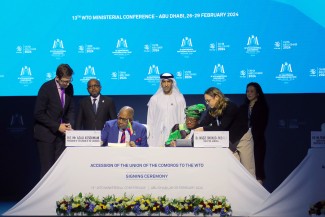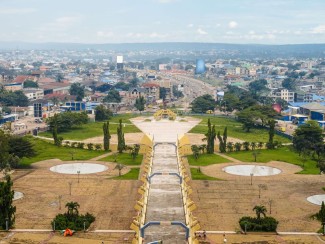** Originally published in World Economic Forum Agenda on 23 March 2020 **
|
|
|
The ongoing death toll from the COVID-19 pandemic in developed countries such as Italy and the United States portends a looming disaster in the world’s most impoverished countries.
The public health responses in some of Asia’s most advanced economies offer lessons to other countries bracing for a potentially dramatic increase in cases, in particular South Korea’s swift, coordinated and within-democratic-means response. But most countries do not enjoy South Korea’s wealth and infrastructure. What is to be done in those nearly 50 countries who fall under the UN’s least developed country (LDC) status, home to nearly 900 million people worldwide? As governments around the world prepare for the worst, what lessons are relevant to those countries that lack the economic resources and medical infrastructure of South Korea?
Take the case of Nepal (a country with which we are deeply familiar): the government has taken extraordinary and necessary measures to prevent the entry of the virus through its borders. It has closed schools, cancelled events, shut down Mount Everest and largely restricted international travel. These actions are courageous considering the enormous economic costs. They are also notable for being achieved through democratic, non-coercive means.
The world's least developed countries (LDCs)
Source: UNCTAD
Nepal, whose population is approximately 28 million people, likely has fewer than 500 intensive care unit beds in the entire country. Many of its rural hospitals lack even minimal inpatient capacity. Diagnostic testing is available at only a single referral hospital in its capital, Kathmandu. As governments in advanced economies announce large-scale economic assistance and healthcare interventions, we also must not neglect our fundamental responsibility to support the response efforts – in a large-scale, ambitious way – for LDCs.
With that in mind, here are six crucial measures that the global community can implement to support LDCs. As places like Taiwan, China, South Korea, Singapore, Japan and Hong Kong bring their outbreaks under control, they can and must contribute their expertise and resources to support LDCs, particularly in Asia.
1. Early, coordinated social distancing is absolutely essential to risk mitigation
Much of the focus in global COVID-19 pandemic responses right now centres around mass social distancing measures – school, event and business closures, working from home, restrictions on travel and social gatherings. These measures are essential and the global community can support such efforts by sharing data, protocols and ensuring regional cohesion in cross-border policies around migration and trade.
2. Make plans now for the expansion of personal protective equipment (PPE) and testing capacity
As international trade and supply chains are decimated, COVID-19 testing and personal protective gear needs to be stockpiled by LDCs right now. They can only do this with extensive financial and technical support from other countries. These donor countries, tragically, are the same ones who have been hard hit by the pandemic. Yet we have to ramp up the manufacturing and distribution of supplies and avoid the perception that we have limited resources to spread amongst all the countries. Even with the ongoing pandemic and the economic crisis, the world has the resources to do this. We have to mobilize like never before.
3. Invest in hospital capacity everywhere
Given the fact that COVID-19 outbreaks disseminate through geographies quickly, targeted, nationalized treatment centres will have minimal impact on severe cases, considering the epidemiology of respiratory viruses like that causing COVID-19. The global community again must mobilize with training (even if largely virtual), supplies and protocols.
4. Connect frontline healthcare workers with the technology, PPE and protocols they need
There is much that can be accomplished by healthcare workers using simple mobile technology to help triage patients and recommend home isolation for those safe to do so. This is essential for focusing scant hospital resources on the sickest patients and avoiding hospital transmission with long queues. Many LDCs like Nepal have themselves pioneered the use of community-based healthcare delivery and promotion activities and can mobilize this infrastructure. They need the right training and technology tools in time to be effective.
5. Ensure uninterrupted supply of essential medicines
As seen with Ebola, there will be disruptions in essential primary care services owing to the COVID-19 pandemic in LDCs. Much can be done to prevent this through working proactively now on supply chains with Ministries of Health around the globe.
6. Ensure early and equitable access to vaccines and medications
While the first wave of response to the COVID-19 pandemic is unlikely to have biomedical tools available to it, preparations should now be made to ensure eventual equitable access to vaccines and antivirals. For influenza, vaccination and anti-virals are almost entirely absent in LDCs, who shoulder an enormous burden of the up to 500,000 estimated annual global deaths due to seasonal influenza.
COVID-19 demonstrates in tragic, bold relief that all countries are in this fight together. Finding the resources to fight it is not a zero-sum game. Indeed, abandoning the world’s most impoverished countries now will only lead to an enormous number of preventable deaths and further global economic instability that puts all of our community at ongoing risk. A truly global fight is a moral priority.
-----------------
Duncan Maru, MD, PhD, and Sabitri Sapkota, MPH, PhD, are with the Arnhold Institute for Global Health and the Department of Health Systems Design and Global Health at Icahn School of Medicine at Mount Sinai.
If you would like to reuse any material published here, please let us know by sending an email to EIF Communications: eifcommunications@wto.org.




